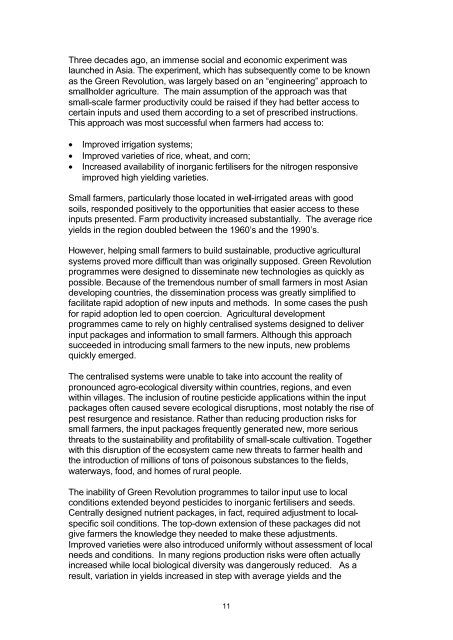pdf, 294 kb - Vegetableipmasia.org
pdf, 294 kb - Vegetableipmasia.org
pdf, 294 kb - Vegetableipmasia.org
- No tags were found...
You also want an ePaper? Increase the reach of your titles
YUMPU automatically turns print PDFs into web optimized ePapers that Google loves.
Three decades ago, an immense social and economic experiment waslaunched in Asia. The experiment, which has subsequently come to be knownas the Green Revolution, was largely based on an “engineering” approach tosmallholder agriculture. The main assumption of the approach was thatsmall-scale farmer productivity could be raised if they had better access tocertain inputs and used them according to a set of prescribed instructions.This approach was most successful when farmers had access to:• Improved irrigation systems;• Improved varieties of rice, wheat, and corn;• Increased availability of in<strong>org</strong>anic fertilisers for the nitrogen responsiveimproved high yielding varieties.Small farmers, particularly those located in well-irrigated areas with goodsoils, responded positively to the opportunities that easier access to theseinputs presented. Farm productivity increased substantially. The average riceyields in the region doubled between the 1960’s and the 1990’s.However, helping small farmers to build sustainable, productive agriculturalsystems proved more difficult than was originally supposed. Green Revolutionprogrammes were designed to disseminate new technologies as quickly aspossible. Because of the tremendous number of small farmers in most Asiandeveloping countries, the dissemination process was greatly simplified tofacilitate rapid adoption of new inputs and methods. In some cases the pushfor rapid adoption led to open coercion. Agricultural developmentprogrammes came to rely on highly centralised systems designed to deliverinput packages and information to small farmers. Although this approachsucceeded in introducing small farmers to the new inputs, new problemsquickly emerged.The centralised systems were unable to take into account the reality ofpronounced agro-ecological diversity within countries, regions, and evenwithin villages. The inclusion of routine pesticide applications within the inputpackages often caused severe ecological disruptions, most notably the rise ofpest resurgence and resistance. Rather than reducing production risks forsmall farmers, the input packages frequently generated new, more seriousthreats to the sustainability and profitability of small-scale cultivation. Togetherwith this disruption of the ecosystem came new threats to farmer health andthe introduction of millions of tons of poisonous substances to the fields,waterways, food, and homes of rural people.The inability of Green Revolution programmes to tailor input use to localconditions extended beyond pesticides to in<strong>org</strong>anic fertilisers and seeds.Centrally designed nutrient packages, in fact, required adjustment to localspecificsoil conditions. The top-down extension of these packages did notgive farmers the knowledge they needed to make these adjustments.Improved varieties were also introduced uniformly without assessment of localneeds and conditions. In many regions production risks were often actuallyincreased while local biological diversity was dangerously reduced. As aresult, variation in yields increased in step with average yields and the11




![Section 4 [ PDF file, 252 KB] - The Field Alliance](https://img.yumpu.com/51387260/1/158x260/section-4-pdf-file-252-kb-the-field-alliance.jpg?quality=85)











